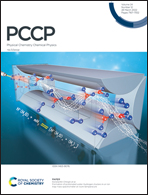Improving the performance of silicon monoxide anodes via tuning a multiple pre-doping system: a first-principles study†
Abstract
Silicon monoxide is a potentially viable anode material for high-performance lithium-ion batteries (LIBs). However, a low initial coulombic efficiency and large volume expansion limit its commercial application. Pre-lithiation is an efficient solution, but is expensive because of limited “pre-lithiation” sources. In this work, we theoretically investigated a novel multiple pre-doping SiO system (Li–NaMg–SiO). By comparing its lithiation behavior to that of the traditional Li-doping system (Li–SiO), we revealed the different doping effects during lithiation. Similar to the traditional Li-doping system, the insertion of Na and Mg disintegrates the Si–O host matrix to form Na–O and Mg–O bonds and active Si clusters. At the end of lithiation, the O–Li coordination number (CN) tends to saturate at CNO–Li ≈ 5 in Li–Na–SiO, Li–Mg–SiO, and Li–NaMg–SiO systems, while the value of CNO–Li in the Li–SiO system is more than 6, which suggests that there are reorganizations between Li, Na, and Mg in the silicate matrix. Doping sources of both Na and Mg can prevent the active Li ions from being trapped by O–Li bonds and increase the initial coulombic efficiency. From the density of states (DOS), we notice that all the different pre-doping systems have similar electronic structures, and they can be expected to undergo the same lithiation process. Furthermore, the higher ion-conductivity and smaller volume expansion during the lithiation process characterized by root mean square deviation (RMSD) and volume analysis prove the advantages of the binary doping system (Li–NaMg–SiO) for the improvement of cycle stability for Si-based materials. These advantages benefit from the loose and amorphous structures of doping systems during lithiation. Our work highlights the doping effects of multiple sources and the promotion of “inert compounds” on the entire lithiation process, which provide valuable insight for high-performance anode design.



 Please wait while we load your content...
Please wait while we load your content...